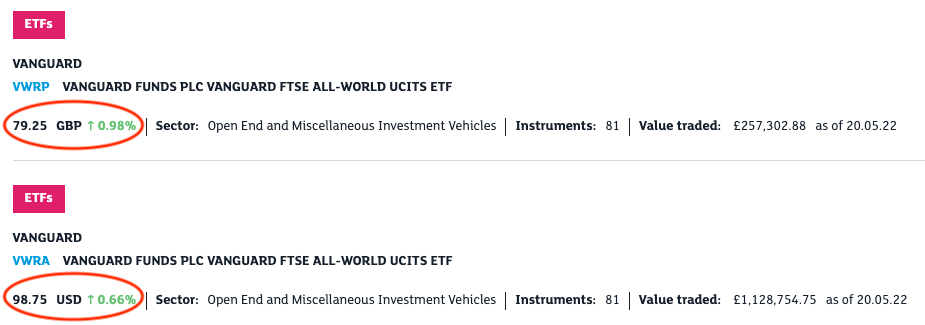The Vanguard LifeStrategy funds are excellent if you want to put your money to work in a quality investment that you can leave to grow over time.
These funds are easy to understand, need minimal maintenance, and should perform well over the long term. There are no worries about constantly having to manage it.
Vanguard LifeStrategy funds are like the iPads of investing. They take a product category that was overly complex and made it super-simple for anyone. All while still delivering good results.
Think there must be a catch – such as that LifeStrategy funds are sub-standard? You’re dead wrong.
The truth about investing is you can achieve life-changing results just by getting the basics right:
- Diversify across the global equity markets.
- Mix your risky equities with high-quality bonds for additional diversification.
- Choose a low-cost fund. This way your money fattens your balance not some fund manager’s.
- Choose passive investing for a great balance of results, simplicity, and best practice.
The Vanguard LifeStrategy funds tick all of these boxes.
What are Vanguard LifeStrategy funds?
Vanguard LifeStrategy funds belong to an investment category known as multi-asset funds.
Multi-asset products bundle multiple asset classes into a single package. It’s a convenient format that contrasts with the majority of funds that specialise in a single market.
Traditionally, you’d construct a portfolio from several individual funds. Each would be invested in a particular market.
For example, you’d choose one fund for UK shares. Another for emerging markets. Yet another for government bonds, and so on.
But LifeStrategy funds do away with all that. Instead they invest across global equity and bond markets in a one-er.
It’s like buying a multi-pack of crisps. Except this bumper deal enables you to scoop the major investment flavours in one easy purchase.
This is known as a fund-of-funds approach. That’s because a Vanguard LifeStrategy fund nests several index funds inside it.
Each nested fund ensures you’re covering a major market. For example here are the individual funds that the Vanguard LifeStrategy 60 fund automatically invests in for you:

Those underlying funds amount to an instant portfolio. Et voila! You’re now diversified around the world in thousands of shares and bonds. But instead of you doing the work, Vanguard did it for you.
Who is Vanguard?
Vanguard has grown to become one of the biggest asset managers in the world. It is famous for index funds and driving down investment costs on behalf of consumers.
Vanguard was founded in 1975 the US by the late John Bogle. Bogle was a visionary. His mission was to offer a better deal to investors and disrupt the fund industry.
It took decades, but Bogle ultimately won the argument. Vanguard’s success forced competitors to respond with their own ranges of cheap index funds and ETFs.
When Vanguard arrived in the UK in 2009 it repeated the trick.
UK investors have enjoyed a cheaper and wider range of investment products ever since. Index tracking funds continue to take market share from the traditional fund industry.
Which Vanguard LifeStrategy fund?
There are five LifeStrategy funds in the range. How do you pick one?
The key difference between the funds is their asset allocation split between equities and bonds.
Here’s the strategic asset allocation for each Vanguard LifeStrategy fund:
| Fund name |
Equity allocation |
Bond allocation |
| LifeStrategy 20 Equity Fund |
20% |
80% |
| LifeStrategy 40 Equity Fund |
40% |
60% |
| LifeStrategy 60 Equity Fund |
60% |
40% |
| LifeStrategy 80 Equity Fund |
80% |
20% |
| LifeStrategy 100 Equity Fund |
100% |
0% |
At one end is LifeStrategy 100. It’s purely invested in equities.
LifeStrategy 20 is at the other end. It is 20% allocated to equities, with the rest in bonds.
The rule of thumb is:
The higher the percentage of equities in a Vanguard LifeStrategy fund, the better its prospects for growing your wealth in the long-term.
Equities have historically been the best performing asset class over most periods of at least ten years.
But there’s a trade-off. Equity-dominated portfolios are riskier. They’re prone to falling harder and faster during stock market crashes and bear markets.
The role of bonds in a portfolio is to take the edge off such stock market slumps.
Bonds have historically earned less than equities over the long-term. But they’re typically less risky in the short-term. That’s because bonds can weather recessions better than equities.
Bonds may even rise in value during a stock market crisis.
Think of equities as wealth rocket-boosters that are prone to misfire.
Bonds can act as parachutes that soften the landing.
However, they don’t always work. And their extra weight slows down your rocket ship a little over time.
In short, picking the right Vanguard LifeStrategy fund means balancing the amount of growth you need versus the risk level you’re comfortable with.
Choosing more equities means exposing yourself to more risk in the hope of greater gains.
Expected equity/bond portfolio behaviour
Here’s how Vanguard illustrates the risk vs reward compromise using historical UK returns:

Notice that the average annualised return increases as you hold more equities. But the downside risk is also more severe.
The minus number reveals the worst return each portfolio suffered in a single calendar year from 1901-2020.
This encapsulates the expected behaviour of the different Vanguard LifeStrategy funds.
You can’t expect a repetition of those precise numbers. But you can expect the LifeStrategy 20 fund to suffer less than riskier, equity-heavier versions in downturns. (Not always, not all the time. But that’s the historical trend.)
Conversely, the Vanguard LifeStrategy 100 is likely to deliver the best returns over the decades. (No guarantees, mind.) Yet watching 50% of your wealth vaporise in a year can be a sickening experience. And this is almost certain to happen at some point.
The risk is that you then panic. You sell up and lock in your losses. Or you lose a large amount of money just before you need it and don’t have time to wait for a bear market recovery.
That’s why choosing a LifeStrategy 100 or even a LifeStrategy 80 fund based on long-term performance is not a no-brainer. They’re too risky for some people.
Which is the best Vanguard LifeStrategy fund for me?
The best Vanguard Lifestrategy fund depends on your attitude to risk and need for growth.
The less growth you require to achieve your financial goals, the less point there is taking on the risk inherent in a 100% equities portfolio.
How much growth do you need? Work that out using our guide to creating an investment plan based on your circumstances.
If you dream of financial independence then try this walkthrough on how to achieve FI.
We can also help you answer the question: “How much do I need to retire?”
To understand more about handling risk, you should read our primer about risk tolerance.
Many people though can’t find the time to make a plan or get to grips with their risk tolerance. Or they discover it’d be easier to nail jelly to a wall.
Instead, you can substitute rules of thumb for a proper plan – at least to get started.
One of the best known rules of thumb suggests you choose your equity allocation like this:
110 minus your age = your equity holding
You can then round up or down to the nearest Vanguard LifeStrategy fund.
Potentially you can even blend Vanguard LifeStrategy funds. Take your equity allocation to 50% or 70% or whatever you prefer.
Rule of thumb assumptions
The rule of thumb above assumes young people can afford to take more risk than older investors.
That’s because young ‘uns have more working years to recover from a stock market crash. And they’ve less wealth on the line in the first place.
But while that’s broadly true, every individual is different.
Ultimately, it’s best to choose a fund in line with your risk tolerance. Because even seasoned investors can find stock market crashes very hard to handle.
Know though that the industry default position is a 60/40 equity/bond asset allocation. That equates to the LifeStrategy 60 fund.
As you close in on your goal, you can mitigate the danger of a stock market crash by transferring from riskier funds into the less volatile LifeStrategy 40 or LifeStrategy 20 fund.
It’s definitely time to consider doing so once a big financial objective (such as retirement) lies within seven years.
Vanguard LifeStrategy performance
Compare the Vanguard LifeStrategy performance below. The graph shows you the cumulative return for every fund in the range since launch in 2011:

Source: Trustnet. Dividends reinvested. The table shows nominal annualised returns.
As a passive investing product, Vanguard LifeStrategy returns are in line with stock market performance and your bond allocation.
Over the last 11 years, you’d be happy with your choice.
Perhaps you’d be less stoked about results over the last year. But that’s not a problem confined to the LifeStrategy range.
Equity and bond markets have had a terrible 2022. This happens occasionally. It’s why investing is said to be risky. Sometimes nothing seems to work.
But given time, world markets recover. Batten down the hatches, ride out the storm, and a diversified portfolio like Vanguard LifeStrategy should deliver over longer periods.
And, as you can see above, the actual performance of the LifeStrategy funds over the past decade or so does resemble the historical illustration we looked at earlier in the piece.
Vanguard LifeStrategy 100 leads the pack, followed by 80, with LifeStrategy 20 bring up the rear.
Vanguard LifeStrategy fund performance in a recession
Where the bond-orientated funds will often show their mettle is in a crash.
Look at the plunge that happened a few months before the June 2020 line in the graph below. You’re seeing the gouge torn out of the markets by the pandemic.
Markets recovered in record speed that time due to massive government intervention.
But the crash still illustrates why bonds can be useful.
Because we can see how the usual LifeStrategy pecking order was completely reversed:

Investors anticipated the mother of all recessions, so they sold down shares. Hence the Vanguard LifeStrategy 20 performed best. Meanwhile the LifeStrategy 100 cratered over 25%.
Granted, the LifeStrategy 20 did still fall nearly 10%. But its large bond allocation acted as a counterbalance to out-of-favour equities. And it rebounded faster than the others, too.
The other LifeStrategy funds dropped progressively more, in relation to bond allocation.
It didn’t matter much in 2020. Because as I said it proved to be the shortest bear market of all time!
However the defensive qualities of bonds could have played a more useful role if the slump lasted years. That does happen.
Nothing is guaranteed
Sadly, bonds don’t always ride to the rescue. High inflation is particularly toxic for bonds and equities.
Both can plummet like Holmes and Moriarty at the Reichenbach Falls when inflation spirals.
That’s what’s happened in 2022. And it’s been bad news for the bond-heavy LifeStrategy funds:

The purple line of the LifeStrategy 100 fell furthest in February and much of March. Just as you’d expect when stock markets come under pressure.
But from April, the hierarchy inverted. Since May the funds have buckled in proportion to their bond holdings. LifeStrategy 20 has actually done worst.
This is an unusual situation, though not unprecedented. Markets are capricious. Sometimes investing reality doesn’t match expectation.
Vanguard LifeStrategy performance charts: what they don’t tell us
Performance charts contain helpful lessons. However they are a bad way to choose between funds.
It’s a hard fact for new (and indeed old) investors to accept. But it is true:
- You do not have the ability to predict which investments will outperform in the future.
- Past performance charts do not contain predictive data. This is stated in all fund literature.
- You can pay someone else to predict the future. But they will probably either overestimate their ability, or else charge you so dearly that you’re actually worse off anyway.
- In many cases they overestimate their ability and charge you dearly. This eats up your profits.
Passive investing products have surged in popularity over the past decade. That’s because the evidence is overwhelming that most people are better off with a passive strategy.
Though past fund performance is not relevant, historic asset class returns do matter.
You can expect a highly-diversified portfolio of equities to outperform bonds and bonds to outperform cash, over the long term. Otherwise, investors would not invest in riskier assets.
Equity returns are your reward for taking the risk that for some years – even decades in extreme cases – equities underperform bonds and cash.
The following three articles explain why you should ignore past performance as a variable, and be wary of anyone’s claims about investing skill:
Vanguard LifeStrategy portfolio
To check the portfolio of each Vanguard LifeStrategy fund you can go to its home page.
Here’s the full line-up.
Once you’re on your fund’s page, tap on the Portfolio Data tab.
Now you can see every individual index fund that comprises your LifeStrategy’s portfolio.
However to save you time, below we’ve plucked out Vanguard’s breakdown of the underlying asset classes held in each portfolio.
(The bond duration data is from Morningstar.)
The Vanguard LifeStrategy 100 portfolio

- 100% equities, 0% bonds
- Bond duration: No bonds, so not applicable
The Vanguard LifeStrategy 80 portfolio

- 80% equities, 20% bonds
- Bond duration: 8.92
The Vanguard LifeStrategy 60 portfolio

- 60% equities, 40% bonds
- Bond duration: 8.98
The Vanguard LifeStrategy 40 portfolio

- 40% equities, 60% bonds
- Bond duration: 9.02
The Vanguard LifeStrategy 20 portfolio

- 20% equities, 80% bonds
- Bond duration: 9.01
What are the Vanguard LifeStrategy fees?
Vanguard LifeStrategy fees range from 0.24% to 0.30% depending on the fund in question.
The Ongoing Charge Figure (OCF) of all Vanguard LifeStrategy funds is currently 0.22%.
Next we must add the (tiny) transaction costs. They vary by fund.
- LifeStrategy 100: 0.02% (transactions) + 0.22% (OCF) = 0.24% total
- LifeStrategy 80: 0.04% (transactions) + 0.22% (OCF) = 0.26% total
- LifeStrategy 60: 0.06% (transactions) + 0.22% (OCF) = 0.28% total
- LifeStrategy 40: 0.06% (transactions) + 0.22% (OCF) = 0.28% total
- LifeStrategy 20: 0.08% (transactions) + 0.22% (OCF) = 0.3% total
What does that total cost percentage mean?
Let’s say your total costs are 0.28%. Essentially, you pay Vanguard £2.80 annually to manage your fund for every £1,000 you have in it.
That’s highly competitive. You can compare it against similar funds by tracking down their OCFs and transaction costs.
Both numbers can be found in the Fees And Expenses section of each fund’s Morningstar page.
Some managers refer to the Total Expense Ratio (TER). That is broadly comparable with the OCF.
Ignore references to Annual Management Charges (AMCs). These exclude important costs and are misleading.
Best way to buy Vanguard LifeStrategy funds
You can buy and sell Vanguard LifeStrategy funds through Vanguard or through other financial platforms. See our broker comparison table.
Currently, investing directly with Vanguard is the cheapest option if you’re just starting out:
- Use Vanguard if your fund portfolio is less than around £40,000.
- Check out Lloyds Bank Share Dealing if your fund portfolio is worth more than £40,000.
Investing in a SIPP
- Use Vanguard if your fund portfolio is less than around £125,000.
- Check out Interactive Investor if your fund portfolio is worth more than £125,000.
Simply choose your platform, set up a direct debit, and then employ your platform’s regular investment tools to automate your investing.
Vanguard LifeStrategy: the good
You get a low-cost, globally diversified, passive investment product in one simple package. It’s an off-the-shelf portfolio that’s extremely low maintenance.
Vanguard automatically rebalances your holdings daily. This helps control risk. And it saves you the time and cost of doing it yourself.
Each LifeStrategy fund’s asset allocation is clearly fixed between equities and bonds.
In contrast rival multi-asset funds typically allow asset class exposure to float over a wide range. That means you don’t really know what you’re getting.
Vanguard is FCA-authorised. The LifeStrategy funds are UK domiciled, so they benefit from the UK’s FSCS investor compensation scheme.
Vanguard LifeStrategy: the bad
The funds hold more UK equities than investing theory suggests is optimal. This skew is called ‘home bias’. It typically exists because people like holding shares in firms from their own country.
The LifeStrategy prospectus states that the UK stock market typically accounts for 25% of each fund’s equity allocation. You’d expect around 4% UK in a global index fund free of home bias.
Taken to extremes, this tendency can leave investors under diversified. But Vanguard hasn’t overdone it. It’s more of wrinkle than a rankle.
Another snag: if your fund is more than 60% invested in bonds and cash at any point during its accounting year then its distributions count as interest payments – not as dividends.
Interest payments are taxed at a higher rate than dividends. So beware if you hold LifeStrategy 20% (and potentially LifeStrategy 40%) outside of your ISA and SIPP tax shelters.
Note: this is a general issue with bond fund taxation. It’s not Vanguard-specific.
Vanguard LifeStrategy: the indifferent
LifeStrategy funds do not invest directly in other asset classes like property and gold.
However, they do hold equities with exposure to these markets (for example, mining companies). And you can add other asset class funds to your portfolio later with specialist index trackers if you want.
Multi-asset funds like LifeStrategy work by holding individual funds within a single ‘fund-of-funds’ wrapper. It is slightly cheaper to hold the underlying funds separately. With LifeStrategy you pay a small OCF premium for the convenience of buying in bulk.
That said, your overall costs may still be cheaper with an all-in-one fund. You’re not paying dealing fees for trading and rebalancing multiple funds.
Either way, the time savings alone are well worth it.
Alternatives
See how rival funds-of-funds stack up.
Read more on the best global trackers.
Vanguard LifeStrategy ETFs exist but not on the London Stock Exchange. These products are multi-asset just like their fund counterparts. Intriguingly, they are free of home bias.
You can buy the LifeStrategy ETFs if your platform enables you to trade ETFs on the German, Dutch, and Italian stock exchanges.
Some financial advisors may also be able to offer home bias-free versions of LifeStrategy. They need to access the LifeStrategy MPS Global range.
Finally, if you’re pondering the differences between the inc or acc versions, this accumulation vs income funds post should help.
Are Vanguard LifeStrategy funds good?
Vanguard LifeStrategy funds are a good investment if you need to invest money to achieve a major financial objective.
Think retirement, financial independence, and sending the kids to Uni in a decade or two.
Are they always best? No, you can always find a different investment which would have been amazing in retrospect. One year it’s crypto, the next it’s oil futures.
But absent a crystal ball, you’re best off choosing a simple, passive, diversified portfolio that captures the growth of the world’s major markets.
Vanguard LifeStrategy does that at a low cost. And you aren’t sacrificing much in the process.
The crucial decision is selecting which version best fits your financial objectives and risk tolerance.
After that you can just review your LifeStrategy fund once a year, and learn a few simple portfolio management techniques that help control your risks as you age.
Take it steady,
The Accumulator

















